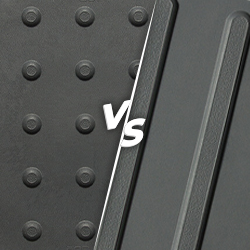









Tactile walking surface indicators (TWSIs) are a crucial accessibility feature in buildings and public spaces, providing critical textured cues for improved navigation and safety for the visually impaired. Two main types of TWSIs exist—tactile domes and detectable bars—which serve complementary purposes. But what exactly distinguishes these two essential tactile systems?
In this blog post, we’ll explore the key differences between tactile domes and detectable bars to develop a deeper understanding of how these accessible design elements enhance spaces.
Tactile domes, also known as truncated domes or detectable warning pavers, are specialized textured tiles used to indicate potential hazards. These warning indicators feature small, flattened dome bumps in a consistent pattern, alert pedestrians to stop, assess their surroundings, and proceed with caution.
Tactile domes are commonly used at:
Transit Platform Edges: Prevent slips and falls at dangerous platform edges
Curb Ramps: Mark the transition from sidewalk to street
Building Entrances: Indicate change in elevation at thresholds
Staircases: Signal upcoming stairs
Pedestrian Crossings: Define the crossing point before vehicle routes
Escalators: Forewarn of moving staircases
The unique feeling underfoot provides a vital cue—“warning, danger ahead.” In addition to the textural pattern, domes often feature bright contrasting colors like safety yellow for high visibility. Compliant domes are essential for potential fall or impact hazards.
Standardized truncated domes in consistent square or radial patterns
Installed at platform edges, stairs, curb ramps, and other hazards
Bright safety yellow or white for visibility
Caution users and mark upcoming dangers
Detectable bars, also called directional bars or guidance bars, are another type of TWSI used to guide pedestrians along pathways and circulation routes. Featuring a series of elongated flat-topped ribs running in the direction of travel, these indicators provide orientation cues for improved accessibility.
Along Pedestrian Walkways - Guide users through open spaces
In Transit Stations - Direct passengers to platforms, exits, etc.
Public Plazas - Safely lead across expansive open areas
Office Lobbies - Direct from entries to key amenities
Government Complexes - Guide through labyrinthine spaces
Unlike domes, the linear ribbed texture signals “follow this path.” Bars make navigation intuitive, allowing users to traverse unfamiliar environments independently. They define accessible routes of travel to key destinations.
Parallel raised bars running in the direction of travel
Installed along designated pedestrian routes
Color contrasting, avoid using yellow
Provide directional orientation cues
While both critically accessible design elements, some key differences between tactile domes vs detectable bars include:
Purpose:
Domes caution users about upcoming hazards
Bars guide users along proper circulation routes
Typical Configuration:
Domes have truncated dome bumps in consistent grid patterns
Bars feature parallel raised ribs running directionally
Placement:
Domes at platform edges, stairs, curb ramps, etc.
Bars along pedestrian walkways and routes
User Experience:
Domes signal “caution” and the need to assess the surroundings
Bars enable intuitive wayfinding through spaces
Color Contrast:
Domes often safety yellow or white for high visibility
Bars use colors contrasting the floor but avoid yellow
While different in purpose and design, tactile domes and detectable bars work together. Pedestrian routes often begin and end with domes that indicate upcoming decision points or hazards. Investing in quality-compliant tactile walking surfaces creates consistently accessible and interpretable cues.
When employing tactile walking surface indicators in Canada, it’s crucial to comply with all relevant accessibility regulations and building codes.
Accessibility for Ontarians with Disabilities Act (AODA)
CSA B651 - requirements for tactile walking surface indicators
Ontario Building Code
National Building Code of Canada
Material durability and strength
Standardized sizes, patterns and layouts
High tonal and color contrast
Beveled edges for a smooth transition
Strategic placement to properly convey meaning
By consulting standards and working with experienced providers, designers can select optimal tactile systems that enhance accessibility and safety.
As Canada’s premier accessibility solutions provider, Tactile Solution Canada supplies high-quality tactile systems from trusted industry brands:
Armor Tile - Cast-in-place and surface-applied polymer composite tactile
Access Tile - Replaceable composite tactile tiles
Advantage Tile - ADA-compliant tactile indicator tiles (Single domes and bars & plates)
Eon – Durable rubber attention and directional tiles
Elan - Premium porcelain tactile pavers
Engineered for strength, durability, and slip resistance
Customizable in various colors, sizes, and dome patterns
Compliant with all Canadian accessibility standards
Backed by 5+ year manufacturer warranties
Let our team of experts recommend the optimal tactile warning systems for your next architectural or landscape project. Contact Tactile Solution Canada today to enhance accessibility, safety, and experience!
The two main types are detectable warning pavers with truncated domes that caution about hazards and directional bars that guide along accessible routes.
Domes are used at stairs, curbs, platforms, etc. Bars are installed along interior circulation paths and exterior walkways.
Yes, domes and bars work in tandem. Pedestrian paths often begin/end with warning domes indicating upcoming decision points.
Relevant regulations include the AODA, CSA B651, Ontario Building Code, and National Building Code of Canada.
Tactile Solution Canada is the premier accessibility solutions provider in Canada, offering a wide selection of compliant tactile warning systems.
Tactile domes and detectable bars serve vital complementary purposes in enhancing accessibility. Investing in compliant, durable, tactile walking surface indicators creates consistently interpretable guidance and hazard cues. With creative solutions now available in various materials, colors, sizes and patterns, selecting tactile products tailored to your spatial needs is important. Consult experienced providers at Tactile Solution Canada to specify the optimal systems to make your next space safer and more accessible.
